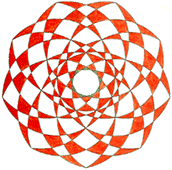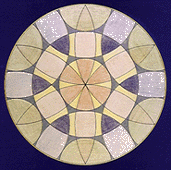|
|

|
Remo F. Roth
Dr. oec. publ., Ph.D.
dipl. analyt. Psychologe (M.-L. v. Franz)
|
 |
© 2005 by Pro Litteris, Zurich, Switzerland and Remo F. Roth, Horgen-Zurich. All Rights Reserved.
dr.remo.roth@psychovision.ch
. Republication and redissemination of the contents of this screen or any part of this website are expressly prohibited without prior psychovision.ch written consent.
This book is intended for private use only, and is copyrighted under existing Internet copyright laws and regulations.
With many thanks to Gregory Sova, Ph.D. and Patricia Sova (LA, CA) for translation assistance
go to index of contents
The Archetype of the Holy Wedding
in Alchemy and in the Unconscious of Modern Man
(Part 1)
1. Introduction
I am a man whose roots stem from a rural milieu. It therefore made a very strange impression on me from the beginning of my studies at the "mother of all Jungian institutions," the C.G. Jung Institute in Zurich 32 years ago, on how they factored out the problem of sexuality and even hushed it up in their social circles. For me, growing up in a peasant environment without too much sexual repression, it was therefore extremely refreshing to experience in my personal relationship with
Marie-Louise von Franz
, that the famous collaborator of Carl Jung was in this regard the great exception. When we talked about the problem of the coniunctio, the Holy Wedding of God and the Goddess so important in Hermetic alchemy, again and again I experienced her exceptional capability to connect these deepest religious facets of Eros with its instinctual aspects. Like this, she helped me to pave my way for an all-embracing understanding of Tantrism. This mystical branch of Buddhism and Hinduism contrasts with Semitic religions in that sexuality is included in their spirituality.
Today it is obvious that the occupation with this far-Eastern way of spirituality is on everyone’s lips. As the prophet is not accepted in his home town – in this case in the Western world – it is mostly ignored that the motif of the coniunctio is one of the central themes of alchemy, especially of its Hermetic branch
[1].
Tantrism however, promotes the awakening of the so-called Kundalini at the coccyx, a process which can for Western people under certain conditions be very dangerous. The danger stems from the fact that people in the West are already too much in the head or Logos consciousness – so seeking illumination by having the Kundalini energy rise to the 7th chakra is the wrong compensation.
On the other hand, the alchemical and especially the Hermetic opus (the work) begins many a time with the descent
[2].
In stercore invenitur
– In the dirt we will find it; the lapis (the stone), or the philosophical gold – was a very important motto of this Medieval mysticism. Thus, to exactly this assumed dirt we should
–
in an introverted way
–
first return, today, instead of aping the deeply religios Tantric mysticism in
the group sex parties of
so-called neo-Tantrism.
In the following I will therefore first deal with the motif of the Holy Wedding or the coniunctio (equivalent to the hierosgamos
– the sacred marriage) in alchemy, and afterwards, in a second part, demonstrate with the help of a modern example, how this archetype emerges anew today out of the unconscious of Western man. We will then see, how it can be integrated in the modern consciousness as a very important aspect of a spiritually understood individuation process. We will further understand that a real revolution the consequences of which we cannot yet at all appreciate, is connected with this archetype and its re-emergence in the human soul of today.
To my great pleasure, also
Marie-Louise von Franz
anticipated such a revolutionary development during the next decades. In one of her last published statements before her death she expressed this revolutionary development with the following closing words
[3]:
"Die von Carl Gustav Jung vorgeschlagene Sicht der Existenz impliziert eine totale Umstellung des Bewusstseins und unserer ganzen Weltsicht. Man kann daher Jungs neues Paradigma nicht nur so nebenbei in dem bisherigen Wissenschaftsbetrieb auch noch mitlaufen lassen. Das sollte meines Erachtens offen diskutiert werden."
English translation:
"The vision proposed by Carl Gustav Jung implies a total reorientation of consciousness and of our whole world view. Therefore one cannot just leave Jung’s new paradigm as an addition in the hitherto scientific world. In my opinion, this fact should be discussed with an open attitude." [translation mine]
It is certain to me that this revolution will not only influence natural science, but also and especially depth psychology as well as medicine. Thus, I will show these influences in the following chapters, which I understand therefore as an empirical affirmation of my teacher’s hypothesis.
2. The archetype of the Holy Wedding (coniunctio) in alchemy – the today constellated creation
myth
 In his book
Psychology of
the
Transference
[4]
(initial picture see on the right) Carl G. Jung had interpreted the alchemical text Rosarium Philosophorum
, which was printed anonymously in the year 1550. Jung’s intention was, with the help of this text, to make the phenomenon of transference and countertransference in the therapeutic process understandable.
At the same time he stressed that "the very word 'transference' is closely akin to 'projection'"
[5]
. In relation to the motif of the union of the opposites we can thus make use of the term in a more general way. This means that we will, for the interpretation of this alchemical text, look at the problem of projection in sexuality between a man and woman in a more general way. Thus, I will especially try to answer the question: What happens if such projections into the partner (of different sex) are withdrawn. We will see that like this the archetypal or even the psychophysical background of this primal drive, and with it the incarnation myth that appears that has a lot to do with the today constellated UFO encounter and abduction phenomenon. In his book
Psychology of
the
Transference
[4]
(initial picture see on the right) Carl G. Jung had interpreted the alchemical text Rosarium Philosophorum
, which was printed anonymously in the year 1550. Jung’s intention was, with the help of this text, to make the phenomenon of transference and countertransference in the therapeutic process understandable.
At the same time he stressed that "the very word 'transference' is closely akin to 'projection'"
[5]
. In relation to the motif of the union of the opposites we can thus make use of the term in a more general way. This means that we will, for the interpretation of this alchemical text, look at the problem of projection in sexuality between a man and woman in a more general way. Thus, I will especially try to answer the question: What happens if such projections into the partner (of different sex) are withdrawn. We will see that like this the archetypal or even the psychophysical background of this primal drive, and with it the incarnation myth that appears that has a lot to do with the today constellated UFO encounter and abduction phenomenon.
It was Carl Jung who first mentioned this much more universal aspect of sexuality. In his work AION
[6] he criticized the purely concretistic interpretation of the term sexuality by Sigmund Freud. He was convinced that the Gnostics, who looked for the "procreative nature of the Whole in the procreative seed", did not mean just the biological sexuality, because they still knew the deep truth
that
"man’s
procreative power is only a special instance of the 'procreative nature of the Whole'." Thus, if one tries to look behind the Freudian concretistic view and therefore wants to
understand the phenomenology of the alchemical Holy Wedding or coniunctio on a deeper, archetypal or even psychophysical level
, one recognizes in the images of the Rosarium – as I will show in the following chapters –
the pattern of a creation myth, wherein
in contrast to most other archaic myths,
man is included as a responsibly acting co-creator
.
As the alchemists thought in categories we now describe with the term microcosmic/macrocosmic parallelism – "as inside, so outside, as above, so below"
[7] – , we will see that we can interpret this creation myth on the one hand on a microcosmic (individual human) level and thus develop out of it a modern method for the cure of physical disease. On the other hand, however, we can apply such an interpretation on the macrocosmic (collective or cosmic) level for the diagnosis and the treatment of the more and more forcefully oppressive collective illness of our Western culture. The first step I explained in other contributions as archetypal psychosomatics, the latter as my psychophysical theory.
When we seek an interpretation of the alchemical texts from the perspective of modern man, we must therefore keep an eye on the above facts. Since in Buddhist and Hindu Tantrism similar ideas prevail that are however much more directly related to the human body and particularly to the sympathetic nervous system, the interpretation of the Rosarium also serves as a deeper understanding of the far-Eastern mysticism. Further, it gives us the answer to the question if we can use these far-Eastern methods in our individuation process, or if we – with our Judeo-Christian history of some thousand years and thus an unconscious that is completely different from the East – must alter it (see also
Neotantrism and Body Centered Imagination
).
[proofread GJS, 4/16/05]
English Homepage Remo F. Roth
back

|